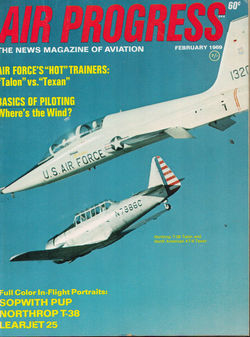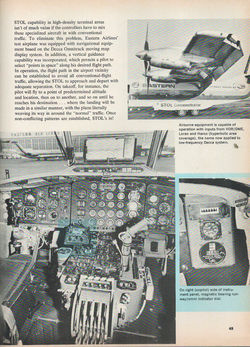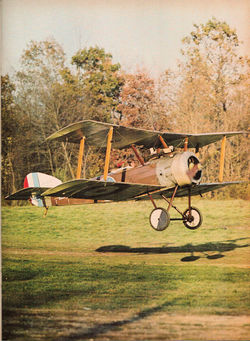AIR
PROGRESS FEB 69 NORTHROP T-38 TALON SOPWITH PUP LEARJET 25 RENO UNLIMITED
CHEROKEE JAL DC-8
THE USAF HOT TRAINER: NORTHROP
T-38 TALON JET: The Northrop T-38 Talon is a two-seat, twinjet supersonic jet
trainer designed and produced by the American aircraft manufacturer Northrop
Corporation. It was the world's first supersonic trainer as well as the most
produced. The T-38 can be traced back to
1952 and Northrop's N-102 Fang and N-156 fighter aircraft projects. During the
mid-1950s, Northrop officials decided to adapt the N-156 to suit a recently
issued general operating requirement by the United States Air Force (USAF) for
a supersonic trainer to replace the Lockheed T-33. The bid was successful, in
no small part on its lower lifecycle cost comparisons to competing aircraft,
and the company received an initial order to build three prototypes. The first
of these, designated YT-38, made its maiden flight on 10 April 1959. The T-38
was introduced to USAF service on 17 March 1961. The USAF is the largest operator of the T-38.
Additional operators of the T-38 include NASA and the United States Navy. U.S.
Naval Test Pilot School in Patuxent River, Maryland, is the principal US Navy
operator. Other T-38s were previously used by the US Navy for dissimilar air
combat training until replaced by the similar Northrop F-5 Tiger II. Pilots of
other NATO nations have commonly flown the T-38 during joint training programs
with American pilots. The T-38 remains in service as of 2023 with several air
forces. As of 2023, the T-38 has been in service for over 60 years with the
USAF, its original operator. In September 2018, USAF announced the replacement
of the Talon by the Boeing–Saab T-7 Red Hawk with phaseout to begin in 2023.
BASICS OF PILOTING: WHERE IS THE
WIND?
FULL COLOR IN-FLIGHT PORTRAIT:
WW1 RFC RAF SOPWITH PUP BIPLANE FIGHTER: The Sopwith Pup is a British
single-seater biplane fighter aircraft built by the Sopwith Aviation Company.
It entered service with the Royal Naval Air Service and the Royal Flying Corps
in the autumn of 1916. With pleasant flying characteristics and good
manoeuvrability, the aircraft proved very successful. The Pup was eventually
outclassed by newer German fighters, but it was not completely replaced on the
Western Front until the end of 1917. The remaining Pups were relegated to Home
Defence and training units. The Pup's docile flying characteristics also made
it ideal for use in aircraft carrier deck landing and takeoff experiments and
training.
FULL COLOR IN-FLIGHT PORTRAIT:
NORTHROP T-38 TALON JET TRAINER
FULL COLOR IN-FLIGHT PORTRAIT:
LEARJET 25: The Learjet 25 is an American ten-seat (two crew and eight
passengers), twin-engine, high-speed business jet aircraft manufactured by
Learjet. It is a stretched version of the Learjet 24.
COLLEGE PILOTS AT COLORADO STATE
UNIVERSITY
MILITARY REPORT
HL-10 ROCKET RUNS: The Northrop
HL-10 was one of five US heavyweight lifting body designs flown at NASA's
Flight Research Center (FRC—later Dryden Flight Research Center) in Edwards,
California, from July 1966 to November 1975 to study and validate the concept
of safely maneuvering and landing a low lift-over-drag vehicle designed for
reentry from space. It was a NASA design and was built to evaluate
"inverted airfoil" lifting body and delta planform. It currently is
on display at the entrance to the Armstrong Flight Research Center at Edwards
Air Force Base.
UNLIMITED RACING AT RENO
NEW PIPER CHEROKEE 140B: The Piper PA-28 Cherokee
is a family of two-seat or four-seat light aircraft built by Piper Aircraft and
designed for flight training, air taxi and personal use.[2] The PA-28 family of
aircraft comprises all-metal, unpressurized, single piston-engined airplanes
with low-mounted wings and tricycle landing gear. They have a single door on
the right side, which is entered by stepping on the wing. The PA-28 is the
fourth most produced aircraft in history. The first PA-28 received its type
certificate from the Federal Aviation Administration in 1960 and the series
remains in production to this day. Current models are the Warrior, Arrow, and
Archer TX and LX,[4][5] and the Pilot 100 and 100i.[6] The Archer was
discontinued in 2009, but with investment from new company ownership, the model
was put back into production in 2010. The PA-28 series competed with the now
discontinued, similarly low-winged Grumman American AA-5 series and Beechcraft
Musketeer designs and continues to compete with the high-winged Cessna 172
JAPAN AIR LINES JAL DOUGLAS DC-8
DITCHES IN SAN FRANCISCO BAY: Japan Air Lines Flight 2 was a scheduled
passenger flight on November 22, 1968.[2] The plane was a new Douglas DC-8-62
named Shiga (志賀), flying from Tokyo
International Airport (Haneda) to San Francisco International Airport (SFO).
Due to heavy fog and other factors, Captain Kohei Asoh mistakenly ditched the
plane near Coyote Point in the shallow waters of San Francisco Bay, two and a
half miles short of the runway. None of the 96 passengers and 11 crew were
injured in the landing.
MR. ALBAR’S STOL MACHINE
McDONNELL DOUGLAS / EASTERN
AIRLINES STOL AIRLINER COCKPIT: The Breguet 941 was a French four-engine
turboprop short takeoff and landing (STOL) transport aircraft developed by
Breguet in the 1960s. Although widely promoted, both by Breguet in France and
by McDonnell Aircraft and McDonnell Douglas in the United States, it was not
built in large numbers; only one prototype and four production aircraft were
built. McDonnell Aircraft acquired a
production licence for the 941 in the United States and began marketing the
aircraft with minimal changes as the McDonnell 188. The company also promoted
an upgraded version with a circular-section pressurised fuselage, uprated
engines, and other enhancements as the 188E. Marketing of the 188E continued
after McDonnell merged with Douglas Aircraft to form McDonnell Douglas, and the
merged company proposed to build an even larger and more powerful version as
the McDonnell Douglas 210. The 941
prototype was tested extensively in both France and the United States.
McDonnell conducted demonstrations with the prototype in late 1964 and again in
early 1965. The aircraft was evaluated by both NASA and the US military, but no
orders were placed. McDonnell Douglas continued these efforts, using a
production 941S for limited passenger operations for two months in 1968 with
Eastern Air Lines between busy urban centers in the northeast U.S. The
following year, this same aircraft was tested by American Airlines and then by
the Federal Aviation Administration to evaluate the STOLport concept for
operation from small city airports. Despite these tests, the company found that
airlines were primarily interested in operating jets from conventional
airports, and did not embrace the novel STOLport concept; no sales resulted and
none of the proposed upgraded versions left the drawing boards.
WINGS OF YESTERYEAR: TANDEM
ENGINE AIRCRAFT
DeHAVILLAND TIGER MOTH BIPLANES
OVER CALIFORNIA








